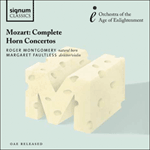
Welcome to Hyperion Records, a British classical label devoted to presenting high-quality recordings of music of all styles and from all periods from the twelfth century to the twenty-first.
Hyperion offers both CDs, and downloads in a number of formats. The site is also available in several languages.
Please use the dropdown buttons to set your preferred options, or use the checkbox to accept the defaults.


Whether or not one accepts the assertion by Benjamin Perl that this concerto has as its genesis an earlier work of Leutgeb’s own composition, the provenance of the Rondo of the D major horn concerto gives us a fascinating glimpse into Mozart’s long-lasting relationship with Leutgeb. Written in the composer’s final year, the manuscript is full of mischievous jibes aimed at the ageing horn player’s weakening embouchure; it also contains hastily written financial accounts, perhaps connected with the costs of putting on concerts.
Mozart wrote the horn part out in full, but never finished the orchestration; his pupil Franz Xaver Süssmayr completed the two-movement concerto in 1792 (Süssmayr’s completion of the Rondo is sometimes listed as K514). However, it is clear that Süssmayr never saw Mozart’s original draft and must have made his version through information from Leutgeb. Not only is the horn part different from Mozart’s original, but the orchestral themes, instrumentation and overall structure are altered as well. Examination of the manuscript also reveals that Leutgeb must have given instructions to alter some of the more difficult passages with requests for additional rests to ease performance. Mozart responds with mischievous banter written above the horn part. Firstly, he indicates the horn part to be taken Adagio, whilst the orchestra plays Allegro. ‘What—finished already?’, he writes at the end of the first main theme. ‘Have a rest’, he taunts; ‘Oh, you’re shrivelling my balls!’ Later, he strikes out a whole section and adds, ‘Take fifteen snacks’. Over a chromatic passage he mocks, ‘at least get one note in tune, Dickhead!’. Aside from the playful element displayed here, it is also fascinating to see how Mozart was quite happy to radically change his composition to suit the performer.
from notes by Richard Payne © 2015
Que l’on accepte ou non l’affirmation de Benjamin Perl selon lequel ce concerto trouve sa genèse dans une œuvre antérieure composée par Leutgeb lui-même, la provenance du Rondo du Concerto pour cor en ré majeur nous donne un aperçu fascinant des relations durables de Mozart avec Leutgeb. Écrit au cours de la dernière année de la vie du compositeur, le manuscrit regorge de moqueries malicieuses visant l’embouchure affaiblie du corniste vieillissant; il contient aussi des comptes financiers écrits à la hâte, liés peut-être aux coûts pour monter des concerts.
Mozart écrivit entièrement la partie de cor, mais ne termina jamais l’orchestration; son élève Franz Xaver Süssmayr acheva le concerto en deux mouvements en 1792 (le Rondo achevé par Süssmayr est parfois classé sous le K 514). Toutefois, il est clair que Süssmayr ne vit jamais le brouillon original de Mozart et dut réaliser sa version grâce à des informations communiquées par Leutgeb. La partie de cor est non seulement différente de l’original de Mozart, mais les thèmes orchestraux, l’instrumentation et la structure de l’ensemble sont également modifiés. L’examen du manuscrit révèle aussi que Leutgeb dut donner des instructions pour modifier certains passages plus difficiles en demandant des pauses supplémentaires pour faciliter l’exécution. Mozart réagit avec des plaisanteries espiègles écrites au-dessus de la partie de cor. D’abord, il indique de prendre la partie de cor Adagio, alors que l’orchestre joue Allegro, «Quoi—déjà terminé?», écrit-il à la fin du premier thème principal. «Respire un peu», raille-t-il; «Oh, tu me casses les couilles»; plus loin, il raye toute une section et ajoute, «prends quinze casse-croûte». Au-dessus d’un passage chromatique, il se moque: «Joue au moins une note juste, abruti!». En dehors de ce côté malicieux, il est également passionnant de voir quel plaisir prenait Mozart à changer radicalement sa composition pour convenir à l’instrumentiste.
extrait des notes rédigées par Richard Payne © 2015
Français: Marie-Stella Pâris
Ob man nun die Theorie von Benjamin Perl akzeptiert oder nicht, nach der dieses Konzert seinen Ursprung in einem früheren Werk von Leutgeb selbst hat, bietet das Rondo des D-Dur-Hornkonzertes einen faszinierenden Einblick in Mozarts langjährige Beziehung zu Leutgeb. Das im letzten Lebensjahr des Komponisten geschriebene Autograph ist voller boshafter Sticheleien über den schwächer werdenden Ansatz des alternden Hornisten; es enthält auch flüchtige finanzielle Berechnungen, vielleicht über die Kosten von Konzertveranstaltungen.
Mozart hat die Hornstimme ganz ausgeschrieben, aber die Instrumentation nicht abgeschlossen; sein Schüler Franz Xaver Süßmayr hat das zweisätzige Konzert 1792 fertiggestellt (Süßmayrs Vollendung des Rondos wird gelegentlich als KV 514 aufgeführt). Er hat aber wohl Mozarts originales Autograph nie gesehen und dürfte seine Fassung mit Hilfe von Leutgebs Informationen erstellt haben. Es gibt nicht nur Unterschiede zu Mozarts Original in der Hornstimme, sondern auch Veränderungen in den Orchesterthemen, der Instrumentation sowie der Gesamtstruktur. Eine Untersuchung des Autographs zeigt zudem, dass Leutgeb Anweisungen gegeben haben muß, einige schwierigere Passagen zu ändern und zusätzliche Pausen zur Erleichterung für den Vortrag einzufügen. Mozart reagiert darauf mit boshaften Neckereien, die er [meist in Italienisch] über die Hornstimme schrieb. Zuerst gibt er für die Hornstimme Adagio an, während das Orchester Allegro spielt. „Was, schon fertig?“, schreibt er am Ende des ersten Hauptthemas. „Hol mal Luft!“, spottet er; „O, das geht mir auf die Nerven“. Später streicht er einen ganzen Absatz durch und fügt hinzu: „15 Jausen“. Über eine chromatische Passage schreibt er spöttisch: „spiel doch wenigstens einen Ton sauber, Dummkopf“. Abgesehen von dem spielerischen Element hier ist es auch faszinierend zu verfolgen, dass Mozart ohne weiteres bereit war, seine Komposition nach den Bedingungen des Interpreten radikal zu ändern.
aus dem Begleittext von Richard Payne © 2015
Deutsch: Christiane Frobenius
 Mozart: Horn Concertos Mozart: Horn ConcertosUnder the direction of Margaret Faultless the OAE shines on these new recordings of Mozart’s Horn Concertos, featuring sublime performances by Roger Montgomery on the natural horn.» More |

